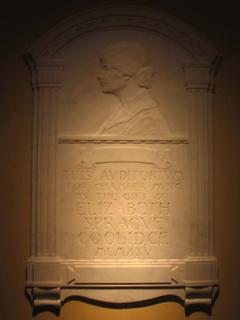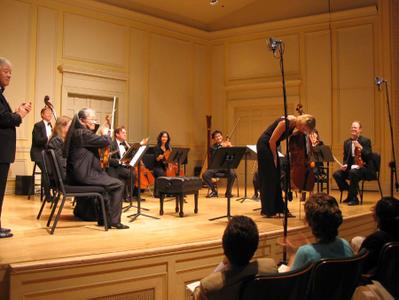Tōru Takemitsu Concert at the Library of Congress
 Apocalyptic, diluvial rain fell on the District of Columbia all day Friday and Saturday. The bad weather probably accounts for the unusually small audience in the Coolidge Auditorium at the Library of Congress on Saturday night, although by the time I left the house the rain had finally stopped. This October 8 concert was not the first of the Library's 80th season of free concerts in the excellent hall provided by the generosity of Elizabeth Sprague Coolidge, one of the great music patrons of the American 20th century. It was, however, the first one Ionarts has attended this fall, and so it was with great joy that I sat down again in the room where Copland's Appalachian Spring and countless other new works have been premiered.
Apocalyptic, diluvial rain fell on the District of Columbia all day Friday and Saturday. The bad weather probably accounts for the unusually small audience in the Coolidge Auditorium at the Library of Congress on Saturday night, although by the time I left the house the rain had finally stopped. This October 8 concert was not the first of the Library's 80th season of free concerts in the excellent hall provided by the generosity of Elizabeth Sprague Coolidge, one of the great music patrons of the American 20th century. It was, however, the first one Ionarts has attended this fall, and so it was with great joy that I sat down again in the room where Copland's Appalachian Spring and countless other new works have been premiered.
In this case, it was a special tribute concert ("Mirror of Tree, Mirror of Field") celebrating the life and music of Japanese composer Tōru Takemitsu (1930–1996). As Jon Newsom, retired Chief of the Library's Music Division, explained in his brief introduction, the composer's wife, Asaka, and daughter Miki had flown all the way from Japan to attend this event. I guess they had arrived not long before, because the composer's poor daughter proceeded to sleep, or so it seemed, through most of the concert. Even those not suffering from jet lag were tempted to doze off, however, because the selection of works on the program were uniform in style, mostly rather slow in tempo and homophonic in texture. If this sort of concert, featuring the music of a single composer from all periods of his career, is the musical equivalent of a retrospective exhibit, this one had a fairly narrow stylistic variety. Perhaps Takemitsu just simply did not write any music that was not meditative or elegiac.
Stephen Brookes, Toru Takemitsu, Timelessly Contemporary (Washington Post, October 11) |
Pianist Audrey Andrist, whom we heard a couple weeks ago at the Corcoran, performed two works with violinist Syoko Aki, who teaches at Yale, and one with the rich viola sound of Maria Lambros. As an example of Takemitsu's experimental side, harpist Naoko Yoshino played Stanza II (1971), with a tape of sounds on a loudspeaker. Takemitsu's relationship to France and its composers -- Debussy, Messiaen, Boulez, Schaeffer, especially -- was evident in the program. The Potomac String Quartet brought us A Way a Lone (1981), which is typical of Takemitsu's literary leanings, based as it is on the final sentence of James Joyce's Finnegans Wake, inasmuch as either "final" or "sentence" can be applied to that book. All of the playing was excellent.
 Conductor Masatoshi Mitsumoto marshalled a large group of string players for two chamber symphonic works, beginning with the series of pointillistic penstrokes called Le Son Calligraphié I and III, from 1958 and 1960, respectively. Even more players entered the stage for Scene (1959). Somehow, the players understood Mitsumoto's batonless motions of stabbing and swirling and provided a lush cushion of dissonance for cello soloist Evelyn Elsing, whose part mimics the human voice in a slow lament.
Conductor Masatoshi Mitsumoto marshalled a large group of string players for two chamber symphonic works, beginning with the series of pointillistic penstrokes called Le Son Calligraphié I and III, from 1958 and 1960, respectively. Even more players entered the stage for Scene (1959). Somehow, the players understood Mitsumoto's batonless motions of stabbing and swirling and provided a lush cushion of dissonance for cello soloist Evelyn Elsing, whose part mimics the human voice in a slow lament.For me, the highlight of the concert was the contribution of superlative flutist Paula Robison. She began the second half with another experimental work, Voice (1971). From the first moments of this piece, the performer blowing through the instrument and then yelling out on nonsense syllables sent the Japanese couple in front of me into laughter that they tried to restrain. Judging by the words that Robison pronounced from the score, first in French and then in English ("Who goes there? Whoever you are, speak, transparence!"), the work is either an exorcism or a summoning of a spirit. It was in the same vein as the work of Robert Dick we heard at La Maison Française this summer. Far more moving was the late work And then I knew 'twas Wind (1992), for flute, viola, and harp, which is the only work that seemed to integrate film score sounds with Takemitsu's literary and musical sensibility. A haunting arpeggiated motive on the harp returned again and again in a piece that was, once again, static but full of gorgeous, dissonant color.





















































2 comments:
Charles, I'm interested that you thought that Takemitsu's And then I knew 'twas Wind (1992), for flute, viola, and harp, seemed to you to integrate film score sounds. While I think this is perhaps his best chamber work (and the best work on the too long LoC concert), I would say that score is pretty much more simply an expansion of the harmonies of Debussy'd similar trio, with the addition of some trills and subtle (and beautiful) tonal effects.
I'm actually most interested in what, had he lived longer, Takemitsu's opera for Lyon,France, commissioned by Kent Nagano, would have sounded like; and whether it would have incorporated -- more prominently -- film score sounds, including musique concrete.
Garth,
Yes, the work is an expansion -- rather personalized -- of Debussy's work for the same forces. Perhaps I am simply demonstrating the influence of Debussy on the sounds of film music by hearing it the way I did.
And, yes, it's a shame that he decided to work on an opera only so late in life and could not finish it.
Post a Comment